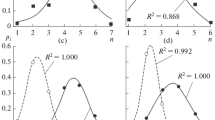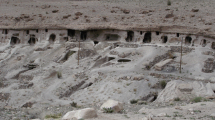Abstract
The term “accessory minerals” is applicable to an expanding range of mineral resources, including rare minerals of anthropogenic deposits and mineral metallurgical wastes. Typical accessory minerals of sedimentary rocks, metallurgical slags and calcines include sulphide minerals of iron, copper, and zinc. This work covers certain chemical transformations of accessory sulphides contained in the wastes of the metallurgical industry. Note that similar behaviors of sulphides may also be observed in the thermal processing of coal. It is shown that, in terms of thermodynamics, thermal processing of products containing precious metals enables application of various methods for generating artificial covellite with silver and gold content through the use of accessory sulphide minerals.
You have full access to this open access chapter, Download conference paper PDF
Similar content being viewed by others
Keywords
1 Introduction
Accessory minerals, in the classical sense, are minerals contained in rocks in small quantities (less than 1%). It may be assumed that the term is also applicable to an expanding range of mineral resources, including rare minerals of anthropogenic deposits and mineral metallurgical wastes. Typical accessory minerals of sedimentary rocks, metallurgical slags and calcines include sulphide minerals of iron, copper, and zinc, often containing precious metals.
This work covers certain chemical transformations of accessory sulphides contained in the wastes of the metallurgical industry. Note that similar behaviors of sulphides may also be observed in the thermal processing of coal. Process mineralogy (Bradsow 2014), recently expanded to include thermal processes (Rubin et al. 2014), is the critical tool when studying the behavior of accessory sulfide minerals.
2 Methods and Approaches
The traditional technology used for the processing of zinc concentrates obtained in flotation concentration of polymetallic sulphide ores envisages oxidizing roasting of the zinc concentrate, in which the main mineral, ZnS sphalerite, is converted into zinc sulphate ZnSO4. The inevitable impurities of pyrite FeS2 and chalcopyrite CuFeS2, present in the zinc concentrates, are also oxidized into the corresponding simple sulfates and oxides at temperatures above 770 °K (Naboichenko et al. 1997). At present, fluidized bed furnaces are predominantly used for oxidizing roasting, with the oxidation process occurring in a hot gas flow in a suspended state.
Despite the obvious benefits, such as high yield and roasting rates, fluidized bed furnaces also have certain disadvantages, including partial underburning of sphalerite due to the rapid formation of a poorly gas-permeable zinc sulfate film on its surface. This inevitably leads to underburning of fine inclusions in sphalerite grains of other sulfide minerals, primarily chalcopyrite. Chalcopyrite is the most common impurity in sphalerite, which is due to the high similarity of the structures of their crystal lattices. It is known that chalcopyrite is most frequently found in the sphalerite structure in the form of very fine grains, down to emulsion shots (Betekhtin 2008). The behavior of chalcopyrite inclusions in sphalerite is significant for subsequent stages of processing of the calcined concentrate.
After the oxidizing roasting, the resulting zinc calcine is subjected to staged sulfuric acid and aqueous leaching of zinc sulfate and oxide-sulfate with the recovery of a zinc sulfate solution to be subsequently used for zinc metal precipitation by electrolysis. Acid and neutral zinc sulfate leaching is performed at temperatures of up to 80–100 °C, additionally enabling chemical transformations of insoluble calcine components on the grain surfaces. The insoluble cake obtained after leaching includes a certain amount of underburned sulphide minerals containing precious metals, primarily silver. It was previously demonstrated (Otrozhdennova et al. 1997; Geikhman et al. 2003) that sulphide minerals remaining in the cake may be flotation concentrated, yielding a froth product containing up to 18% of sulfide sulfur and up to several kilograms of silver per ton.
We have studied the composition of concentrates obtained by flotation concentration of the cake generated after zinc sulphate leaching at three metallurgical enterprises in different countries. The studies were performed using a Camscan scanning microscope, an Analysette laser microanalyzer, a Geigerflex X-ray phase spectrometer, optical microscopy tools, etc.
It was found that there was no fundamental difference in the material composition of such concentrates at different metallurgical plants. This is explained by the similarity of the ore bases and of the metallurgical treatment structures used at the mining enterprises analyzed. Sphalerite (70–80%) is the main mineral found in the composition of the concentrates, followed by such spinel-structure minerals as MeFe2O4, covellite, oxide compounds of zinc and iron (several percent), and traces of chalcosite.
In terms of their elementary chemical composition, the concentrates were represented by zinc 45–48%, total sulfur 20–22%, sulfur sulfide 17–19%, iron 11–14%, silica 2.5–4%, and copper 3–4%. The silver content was 0.2–0.4% (2–4 kg/t); the gold content was 10–15 g/t.
3 Results and Discussion
The most important finding is the presence of copper sulphide covellite CuS in the flotation concentrate, in which the bulk of silver is concentrated. The availability of silver-containing films of copper sulfides (without their identification) on the surfaces of sphalerite contained in the zinc cake flotation concentrate has been indicated previously (Otrozhdennova et al. 1997). We have established that covellite forms distinct substances on the sphalerite surface. No native silver was found in the samples. Gold is present in the form of fine grains containing silver and copper. The gold sample is 700–930. Copper-containing metals in the source zinc concentrate entering the roasting process are represented almost exclusively by chalcopyrite, including its aggregates with sphalerite.
Two main methods of covellite formation in the metallurgical processing of zinc may be considered in this regard. The first is the interaction of dissolved copper sulfate with the sphalerite surface in sulfuric acid leaching of zinc calcines, with the formation of covellite films in the course of the resulting exchange reaction and with the transition of zinc ions into the solution. The second possible source of covellite is the transformation of fine chalcopyrite inclusions contained in sphalerite grains with the migration of the resulting covellite to the sphalerite surface due to the strong differences in the structures of their crystal lattices. None of these methods has been subjected to special experimental verification. Given that even isomorphous substitution of copper with silver can occur in chalcopyrite, despite the difference in the electron spiral radii of silver of 1.26 Å and copper of 0.96 Å, it may be assumed that silver-containing covellite may be generated using these methods, especially considering the effects produced on such processes by associated minerals.
Let us consider the thermodynamic feasibility of the two hypothetical processes of formation of man-made covellite. In the below calculations of the free energy of the processes and their enthalpy and entropy increments, known reference data are used for reactions (I) and (II). These calculations show that reaction (I) can occur spontaneously, which is facilitated by the entropy effect, and reaction (II) requires external energy inputs, which does not contradict the conditions of respective production processes (Tables 1 and 2).
4 Conclusions
In terms of thermodynamics, combined thermal processing of products containing precious metals enables application of various methods for generating artificial covellite with the participation of accessory sulphide minerals. Respective statements may be useful for both metallurgical processes and thermochemical processing of hard coals, which always contain impurities of sulphide minerals.
References
Betekhtin AG (2008) Course of Mineralogy. Publishing House University, Moscow (2008)
Bradsow D (2014) The role of ‘Process mineralogy’ in improving the process performance of complex sulfide ores. In: Proceedings XXVII IMPC, C.14, pp 1–23
Geikhman VV, Kazanbaev LA, Kozlov PA (2003) Industrial tests of flotation of zinc cakes. Non-ferrous Met (1):29–32
Otrozhdennova LA, Maksimov II, Khodov NV (1997) Combined technology of silver recovery from zinc cakes. Min J (4):39–40
Naboichenko SS (1997) Processes and devices of non-ferrous metallurgy. USMU, Ekaterinburg
Rubin S, Aksenov A, Senchenko A, Lagutina S (2014) Argentojaroside synthesis and research. In: Proceedings of the XXVII IMPC, C.19, pp 209–213
Acknowledgements
The work was carried out with the support of the Russian Science Foundation (project No. 17-17-30015).
Author information
Authors and Affiliations
Corresponding author
Editor information
Editors and Affiliations
Rights and permissions
Open Access This chapter is licensed under the terms of the Creative Commons Attribution 4.0 International License (http://creativecommons.org/licenses/by/4.0/), which permits use, sharing, adaptation, distribution and reproduction in any medium or format, as long as you give appropriate credit to the original author(s) and the source, provide a link to the Creative Commons license and indicate if changes were made.
The images or other third party material in this chapter are included in the chapter's Creative Commons license, unless indicated otherwise in a credit line to the material. If material is not included in the chapter's Creative Commons license and your intended use is not permitted by statutory regulation or exceeds the permitted use, you will need to obtain permission directly from the copyright holder.
Copyright information
© 2019 The Author(s)
About this paper
Cite this paper
Gerasimov, A., Kotova, E., Ustinov, I. (2019). Applied Mineralogy of Anthropogenic Accessory Minerals. In: Glagolev, S. (eds) 14th International Congress for Applied Mineralogy (ICAM2019). ICAM 2019. Springer Proceedings in Earth and Environmental Sciences. Springer, Cham. https://doi.org/10.1007/978-3-030-22974-0_16
Download citation
DOI: https://doi.org/10.1007/978-3-030-22974-0_16
Published:
Publisher Name: Springer, Cham
Print ISBN: 978-3-030-22973-3
Online ISBN: 978-3-030-22974-0
eBook Packages: Earth and Environmental ScienceEarth and Environmental Science (R0)




